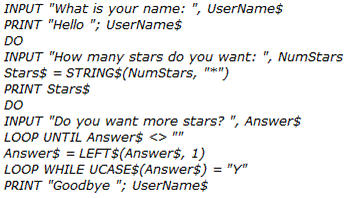BASIC Programming Assignment Help
Hire Basic Programming Assignment Help Experts Online

Basic is simple computer programming languages. Urgenthomework.com provides excellent online help services in BASIC homework Help, BASIC Online Help, Programming Assignment Help, BASIC programming help, BASIC Programming assignment help and BASIC Projects for students. BASIC Assignment Help is one of the subject in which we provide homework and assignment help to the students at urgenthomework.com.
What is BASIC Programming language?
BASIC programming language is one of the earliest and simplest high-level programming language which was a popular choice among many persons in 1970s, because of its simplicity and easy to learn capability. BASIC stands for Beginner's All-purpose Symbolic Instruction Code. The popular language was developed by John Kemeny and Thomas Kurtz in 1960s at Dartmouth College. Even though of its simplicity, its widely used for Business application also.
Developer of BASIC language assumes that all the users of the language must aware about English language which is also known as Human interface language. So the basic element of Human Interface language is included in BAISC Programming language that you can see in below example: to input any string INPUT keyword is used and to print any statement PRINT keyword/command is used. The language is constantly and widely used as easy to learn quickly and the statements are easily read by the programmer of this language. As we discussed early BASIC language used in many business application, as considered to be a valid choice as a programming language. So there is an advancement in standard BASIC that is Microsoft's Visual basic which add some features of object-oriented and standard BASIC programming language. Now we are going to discuss the advantages of Visual Basic.
Advantages of VISUAL BASIC Programming language
As the structure is very simple, same as the executable code and VB is not only programming language but also support its own IDE i.e. Integrated Development environment. The GUI is easy to develop in this language as connect them to handler function. The language support Intellisense technology, which is a little popup when a programmer editing or writing the code about the keyword he is constructing. It also has its COM component model which attuned by Microsoft COM.
Basic Sample Code Is:
INPUT {"what is your name: "}, UserName$
PRINT {"Hello "}, UserName$
DO
INPUT {"How many stars do you want: "}, NumStars
Stars$ = STRING$(NumStar, {"*"})
PRINT Star$
DO
INPUT Do you want more stars? ', Answer$
LOOP UNTIL Answer$ <> {""}
Answer$ = LEFT$(Answer$, 1)
LOOP WHILE UCASE$(Answer$) = {"Y"}
PRINT {"Goodbye "}; UserName$

Sample Java Basic Programming Assignment Help Solved
The solution to this problem must be done using Java threads or Python threads. Your Runner class should be stored in a file called FinalRunner.java or FinalRunner.py. You will likely need several other classes. Your main method must be in the FinalRunner file. Due to budget cutbacks, the postal services at UW-Oshkosh can only afford 1 mail deliverer. Even worse, that deliverer is a student who works part-time. Postal services wants to minimize the amount of time that student has to work in order to save money. Because of this, they are interested in the fastest way to visit all buildings and return back to the Campus Services Building, BldgOne in the example below. There are obvious routes that are terrible (e.g. going from one side of campus to the other and then back) but the optimal route is not obvious. Your goal is to read in a file that gives the time in seconds to get from a building to every other building and determine the best possible route such that you start at the building listed on the first line, visit all other buildings and end at the building listed on the first line. The building names in the example below are arbitrary and can be called anything.
The input file you will read in is called input2.txt and will be formatted in the following manner:
BldgOne : t(BldgOne) t(BldgTwo) t(BldgThree) t(BldgFour) t(BldgFive) BldgTwo : t(BldgOne) t(BldgTwo) t(BldgThree) t(BldgFour) t(BldgFive) BldgThree : t(BldgOne) t(BldgTwo) t(BldgThree) t(BldgFour) t(BldgFive) BldgFour : t(BldgOne) t(BldgTwo) t(BldgThree) t(BldgFour) t(BldgFive) BldgFive : t(BldgOne) t(BldgTwo) t(BldgThree) t(BldgFour) t(BldgFive)
Take the first line for example. t(BldgTwo) will be an integer value denoting the number of seconds it takes to get from BldgOne to BldgTwo. On the first line, t(BldgOne) will be 0. In other words, it takes 0 time to get from BldgOne to BldgOne. The input will always be formatted in this manner. If another building is constructed, it will be added to the end and the file will be updated accordingly. For example, if BldgSix were constructed, the time to BldgSix will be added at the end of every list and BldgSix will be added to the end of the file. The time from BldgOne to BldgThree may not be the same as the time from BldgThree to BldgOne. There may be one-way streets; it may be uphill, etc.
A sample input file is shown below: ABC : 0 5 7 3 def: 4 0 3 6 ghi: 6 4 0 4 Jul: 4 5 6 0 Each row in the sample input will start with the building ID3, followed by a space, 3 Building ID’s will not contain any whitespace but could be any other sequence of letters, numbers or special characters. followed by a colon, followed by another space, then followed by a list of integer values to get to all of the other buildings where each value is separated by a space. Your goal is this, for the best route possible, print out the total time taken to start with the building on the first line, visit all buildings and then return to the building on the first line. You must also output the order in which you visited the buildings using the name of the buildings as defined in the input file. You should also output the total route cost. In the above example, there are only 6 possible routes.
Each of them is shown below with their route cost and total cost at the end:
ABC → def → ghi → jkl → ABC: 5+3+4+4 = 16 ABC → def → jkl → ghi → ABC: 5+6+6+6 = 23 ABC → jkl → def → ghi → ABC : 3+5+3+6 = 17 ABC → jkl → ghi → def → ABC: 3+6+4+4 = 17 ABC → ghi → def → jkl → ABC: 7+4+6+4 = 21 ABC → ghi → jkl → def → ABC: 7+4+5+4 = 20
- Your output file, which should be called output2.txt would contain the following answer: ABC def ghi jkl ABC 16 A few constraints on your solution are given below:
- In order to get from BldgA to BldgC, the direct path will always be the best path. In other words, if going from BldgA to BldgC, then going directly from BldgA to BldgC will always be faster than to go from BldgA to any other arbitrary building (say BldgB) to BldgC4.
- Your code must split up the computation in a reasonable fashion. Think about the solution space and how the potential solutions can be split up and checked in parallel. c. Your code must run faster than my brute force non-parallelized way of solving it.
- My brute force solution that uses no multithreading and is not 4 For those interested, this is called the triangle inequality. The input will not break this rule. You do not have to do anything to test for this as the input will adhere to this rule. optimized checks all potential solutions with 12 buildings. It runs in roughly 60 seconds.
- Because this problem blows up in complexity, your code only needs to work for up to 13 buildings. As a guideline5, my threaded code with 13 buildings takes ~3.5 minutes to run on a t2.2xlarge EC2 instance (8 CPUs) and it ran in ~12 minutes when using a t2.large EC2 instance (2 CPUs).
- Do not prompt the user or expect the user to enter in any arguments. The input file is input2.txt and the output file is output2.txt. Along the same lines, the number of buildings is an arbitrary size and should be determined by reading in the input file. Do not ask the user for this information. The input2.txt file should be in the same folder as your Java or Python files.
Topics in Programming
- Ada
- Assembly Language
- AutoCAD
- BASIC
- Computer virus
- C Programming
- Euphoria
- Fortran Homework Help
- Game programming language
- Java Assignment Help
- JavaScript
- Java Servlets Help
- Machine Language
- Matlab
- Pascal
- Perl
- PHP
- Python
- Ruby
- Servlet Life Cycle
- Smalltalk
- SOAP
- Visual Basic
- COBOL
- Lisp
- Logo Help
- Plankalkul Help
- Prolog
- REBOL
- Rexx
- Scheme Help
- TCL
- ToonTalk Help

